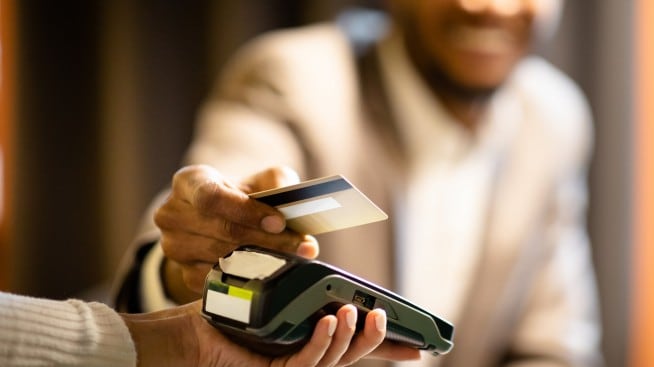Why won't your credit card swipe?

Like any product that is handled regularly, your credit card (and debit card) will likely see some wear and tear over time. If grime and scratches become excessive, you may find yourself unable to swipe your card at a really inconvenient time.
Chip technology and tap-to-pay may be now available, which replaces the need for a magnetic stripe, and essentially the entire need to "swipe" a card through a reader. However, with so many cards supported by the stripe still in circulation, it's important to know how to troubleshoot when you encounter difficulties with your card.
Why can't I swipe my credit card?
Below are six reasons why your credit card won't swipe, what you should know about the magnetic stripe and some suggestions for preventing damage to it in the future.
1. You need to use your chip to pay
Chip cards have been rolled out by credit card issuers in recent years. You'll notice most cards have both a chip and a magnetic stripe on the back. However, if you only have stripe technology and swipe your card at a terminal that only accepts chips, you may find it rejects your payment.
2. You scratched or damaged the stripe
The magnetic stripe on the card is made up of tiny iron-based magnetic particles that convey information when swiped through the credit card reader. Over time, these magnetic particles may get muffled or severed by normal wear and tear. This means the magnetic stripe may be unable to retrieve the identifying information it needs to complete the transaction.
3. Your credit card is dirty
Your card may touch many surfaces, or hands, every time you pull it out of your wallet. Over time, dust, scratches and oil from your fingers will buildup. You may find that your credit card won't swipe.
4. Your credit card may have overheated
Leaving your credit or debit card in a hot car or directly in the sun can cause damage. The heat can make the plastic malleable, leading to a distorted shape. If the card loses its shape, the magnetic stripe may no longer be swiped and read correctly.
5. Your wallet or bag uses a magnet
As mentioned above, the magnetic stripe on your credit card uses magnetic particles to identify the credit card information when swiped at the point of purchase. Placing magnets close together can cause them to repel each other. So if your purse or wallet has a magnetic enclosure element and your credit card is exposed to that element for an extended period of time, it may interfere with the magnetic stripe’s ability of being read at a terminal.
6. You brought your card near an electromagnetic field
Similarly, devices or machines that emit an electromagnetic field may interfere with the magnetic stripe on your card. This includes MRI machines and microwaves. They have such strong magnetic forces that the stripe on your credit card may lose its functionality simply by being close to the machine.
If any of these things happen to your card, you'll want to contact your credit card issuer immediately and request a replacement card. Bear in mind that you might be charged a fee for that replacement. In the meantime, some merchants may have checkout terminals that allow you to manually type in your credit card information, and of course you'll still be able to make purchases online as long as your card is still active.
Can you clean a magnetic stripe on a credit card?
Yes you can clean the magnetic stripe (and the whole card while you're at it). Plastic credit and debit cards are designed to be water resistant, so you can clean both the magnetic stripe and the chip as well as the rest of the card.
To begin, grab antibacterial spray (a wipe will work too), or mild dish soap and follow these easy steps:
- Spray your preferred cleaning solution into a clean rag or cotton ball. Do not spray the solution directly onto your card.
- Gently wipe the rag or cotton ball over the entire front and back of your card for about 10 to 20 seconds. Do not scrub it abrasively as this can cause damage.
- Place the card somewhere to dry completely before returning it to your wallet.
How does the magnetic stripe on my credit card work?
The magnetic stripe on your credit card is how the merchant and the bank are able to exchange information about you and your account. The stripe contains information about the cardholder such as their name and address, the account number, the expiration date and the security code. When your card is swiped (or tapped), this information is sent to a server, the account information is confirmed and the transaction should be authorized or rejected.
How do I know if my credit card is demagnetized?
Your credit card can become demagnetized, and therefore unusable, if it comes in contact with anything else magnetic. This is because the competing magnets can cause the encoded information within the stripe to be erased.
This includes refrigerator magnets, security tags on clothing, merchandise, magnetic enclosures on purses and belts and anything else that has a magnetic field around it.
If you find that your credit card won't swipe after exposure to a nearby magnet or electromagnetic field, it may have been demagnetized and you'll need to have it replaced.
You may also want to set up a digital wallet, which allows you to have your card available anywhere your device is. You can be confident knowing that your card number is never saved in your digital wallet or shared with merchants. This digital wallet acts the same as your physical wallet, and allows you to make purchases without the plastic.
In conclusion
There are many reasons why a credit card won't swipe correctly. Most often this is because of normal wear and tear. If you're unable to fix it or the card is damaged beyond repair, contact your card issuer for a replacement card. It typically takes between 3 and 7 business days to receive a new card. Some issuers may even offer expedited shipping for free.
Some alternatives to magnetic stripe cards are chip cards, which allow you to make contactless payments, or digital wallet using your smartphone. Neither of these options require a swipe or frequent handling of the card which can increase the longevity of it.



